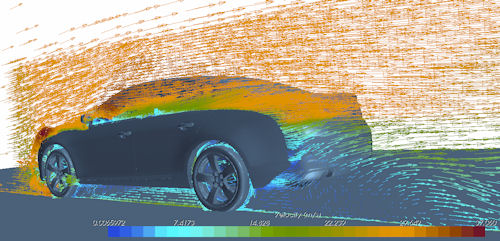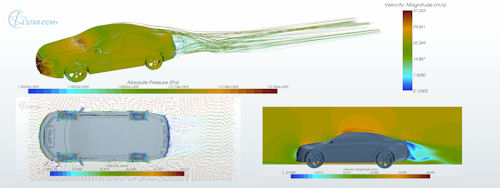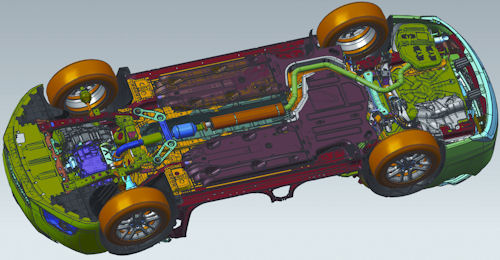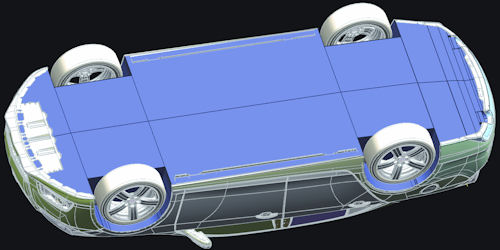Latest News
September 1, 2012
By Kenneth Wong
On Friday June 22, Domenic Barsotti and his friends, known as the EcoEagles, received their car, courtesy of GM. It now sits inside a small garage in the Lehmen Building, part of Embry-Riddle Aeronautic University’s 185-acre Daytona Beach campus. The pearl-white 2013 Chevy Malibu seems to complement Miami’s sun-lit, palm-lined landscape. Even though it was the first time Barsotti had laid eyes on the vehicle, he felt he knew it inside-out.
 |
| To design a better Chevy Malibu for the EcoCar2 contest, the Embry-Riddle team studied the velocity vector plot through the mid-plane of the wheels in CD-adapco’s STAR-CCM+. In this simulation, the wheels are set to rotate. The ground plane is also traveling at 50 mph. |
Barsotti drives a Honda Civic in his regular commute, but, for the past year, he and his friends at Embry-Riddle had been studying the Chevy Malibu 2013’s engine bay, cooling system, powertrain, and body structure in highly detailed 3D digital models, created in Siemens PLM Software’s NX. The EcoEagles are one of 15 teams, each representing a prestigious university in the EcoCar2 Competition, organized and sponsored by the U.S. Department of Energy and GM. The three-year competition asks contestants to “Plug into the Future” by “]reducing] the environmental impact of a Chevrolet Malibu without compromising performance, safety, and consumer acceptability.”
The EcoEagles are betting on a front-wheel-drive series plug-in hybrid electric vehicle (PHEV) system. Since the real vehicle needs to periodically go on promotional tours and roadshows, dismantling the car and outfitting it with various experimental drive systems isn’t a feasible option. It’ll be up to Barsotti, in charge of the team’s computer-aided engineering (CAE) studies, to test out and validate most of the ideas under consideration in a mixture of high-end simulation packages, including ANSYS, CD-adapco’s STAR-CCM+, and MathWorks’ MATLAB.
Balancing Performance and Aesthetics
The EcoCar2 competition, modeled on GM’s real-world vehicle development process, has four primary technical goals:
- Reduce fuel consumption.
- Reduce well-to-wheel greenhouse gas emissions.
- Reduce criteria tailpipe emissions.
- Maintain consumer acceptability in the areas of performance, utility, and safety.
The first three goals are not impossible to achieve, but the fourth sums up the challenge for participating teams: They must accomplish the objectives without sacrificing the Chevy Malibu’s consumer appeal.
“You can put all kinds of aerodynamic devices to reduce drag, but, in the end, if it looks like an ugly car, no one will ever want to buy it,” reasoned Barsotti.
According to the EcoEagles’ description, their system promises to “run on both grid electricity and B20 biodiesel fuel. The vehicle will be capable of being driven as an electric vehicle for more than 40 miles by using AM-Racing, Remy electric motors and an A123 Systems lithium-ion battery pack. The EcoEagles are using a GM 1.7 L diesel engine and a Remy generator to sustain the battery. The small GM diesel engine was chosen because of its high efficiency and the low environmental impact associated with B20 biodiesel.”
The EcoEagles are investigating, among other things, the use of phase-change materials (also called latent heat storage units) for battery cooling. “I believe we are the only ]team] that looked into it and proved that it’s a viable option,” said Barsotti.
They are also considering replacing the vehicle’s side mirrors with cameras for better navigation and drag reduction. In both cases, the use of digital simulation to study the design’s impact plays an important role. In exploring phase-change materials, the team needs to employ heat transfer analysis; in mirror replacement, the team needs to understand how the change in geometry will affect the car’s air flow.
 |
| Simulation results for the Embry-Riddle team’s design study. Top image shows surface pressure on the vehicle with velocity streamlines. Bottom left image shows a velocity vector plot through a plane that is about 3/4 of the way up the tire. Bottom right image shows velocity through the mid-plane of the vehicle. They are simulated with a vehicle with rotating wheels and a moving ground plane traveling at 50 mph. |
EcoCar2 competing teams received complementary software licenses from sponsors, including CD-adapco, dSPACE, MathWorks, and Siemens PLM Software. Since the original digital data provided by GM is delivered in NX format, access to Siemens PLM Software’s NX program gives contestants a way to read and edit the models without translation.
For Barsotti, access to CD-adapco’s STAR-CCM+ is a boon, as he regularly relies on it for CFD studies. “The Optimate+ plugin for STAR-CCM+ allows the use of Red Cedar Technology’s powerful SHERPA optimizing algorithm to alter the design of our new camera pods quickly and efficiently and to minimize drag in a way that wasn’t possible before,” noted Barsotti. “Its seamless integration into STAR-CCM+ made it fast and easy to incorporate into our design process.”
For heat transfer, the EcoEagles use ANSYS, a program they have become familiar with in classroom exercises. As part of the simulation deals with embedded software and control systems, the team also uses MathWorks MATLAB, a programming environment for data analysis, and dSPACE, a development and testing platform for embedded software, control software, and mechatronics.
Model Simplification is the First Step
Because loading the GM-supplied 3D models in native NX format (complete with manufacturing details, such as adhesives for doors) into a CFD program is time consuming, Barsotti uses Parasolid (the geometric format native to Siemens’ software packages, also widely used by many CAD software developers) as the intermediary lightweight format. When possible, Barsotti reduces the complexity of the model using NX’s Synchronology Technology, a direct-editing method. (For more on this topic, read “Direct Modelers as FEA Preprocessors, Part I and Part II,” April-May 2012.)
 |
 |
| The original vehicle model’s floor section (top), even with some details omitted, is still too complex for analysis. Barsotti used NX software’s Synchronous Technology to reduce the model to a solid piece of geometry (bottom). |
Because of Embry-Riddle’s long tradition in aerospace engineering, the faculty and its students are more familiar with Dassault Systèmes’ CATIA, a software package widely used in aerospace industry. However, despite limited exposure to NX, Barsotti found that NX’s Synchronous Technology, which lets users push and pull on faces to create or edit geometry, gave him an easy way to strip out unnecessary details.
When analyzing the engine bay, Barsotti simplified it by reducing the amount of details and holes in the model. Similarly, when preparing the floor of the vehicle, he turned the model into solid, flat geometry. These treatments reduced the computation required to solve the analysis scenarios and produce the results faster. (Even a simplified model still contained roughly 16 million cells, Barsotti estimated.)
“The Wrap allowed for a quick ‘Wrap’ of the grills that quickly sealed the engine bay,” noted Barsotti. “Also, the Wave geometry linker allowed the flat floor to be drawn with linked dimensions to the body’s shell without any risk of modifying the original design of the vehicle.”
HPC on a Smaller Scale
The EcoEagles’ garage is equipped with a Dell Precision T7500 workstation, powered by dual CPUs (two CPUs, offering 12 processing cores), 24GB RAM, a NVIDIA Quadro 2000 professional GPU, and a 120GB solid-state drive. A SpaceMouse from 3DConnexion rounds out the system.
“CD-adapco is nice enough to give us HPC licenses, so we could use all 12 cores,” Barsotti remarked. Running analysis software on multiple CPU cores lets you obtain the results faster; however, doing so often requires special licenses, often called HPC licenses.
As powerful as the Dell Precision workstation is, Barsotti explained some of the analysis jobs took an entire day to converge even when processing on all 12 cores. Furthermore, when the system is engaged in analysis jobs, it has no remaining processing power for anything else. Out of consideration for others who might need access to the workstation, Barsotti usually schedules his analysis jobs to begin at the end of the day.
One advantage STAR-CCM+ offers, Barsotti explained, is the option to pause a job in progress. “You can stop the solver at any time, then start up again at a later time,” he said. “Obviously I share the workstation with others, so if someone has to use the workstation, I can stop my simulation, save it, then start it again later.”
He also showed his teammates how to stop a simulation, then reload it on fewer number of cores: for example, switching the simulation to run from 12 cores to 8, thus leaving four free cores to run other programs (such as email, web browsers, or CAD) while the simulation continues in the background.
Experiments in Bits and Bytes
On July 25, the EcoEagles provided an update to its fans through their Facebook page: “Our vehicle dynamometer has arrived. Installation into the EcoEagles’ garage begins next week. Exercising our hybrid power system with it allows development in a controlled, repeatable environment.”
One fan responded: “Can’t wait to see that baby in action!” Another wondered: “No laps around the ICI (Intramural and Recreational Sports, part of the campus)?” To the fans’ delight, the page admin responded: “We will definitely do laps.”
Competition is fierce. The EcoEagles are going up against worthy rivals, who hope to harvest fuel-cells, ethanol, and lithium-ion battery to boost the Chevy Malibu’s performance. The contest organizer’s official blog “Inside the Green Garage” revealed that, like the EcoEagles, teams from the University of Victoria and Colorado State University are also digitally simulating their vehicles’ operations inside dSPACE’s vehicle dynamics mode.
All the teams received their own test vehicle this June, but they began designing long before the car arrived. They started putting together their Chevy Malibus inside their workstations in pixels nearly a year ago; they’ve been crash-testing them in cells and meshes in finite element analysis programs since then.
Kenneth Wong is Desktop Engineering’s senior editor and resident blogger. He’ll be the first to admit that his driving skills are better suited for digital simulation than the real world. Reach him at [email protected] or visit his blog at deskeng.com/virtual_desktop.
More Info
3DConnexion
ANSYS
CD-adapco
Dassault Systèmes
Dell
dSPACE
EcoEagles
Embry-Riddle University
Inside the Green Garage
MathWorks
NVIDIA
Red Cedar Technology
Siemens PLM Software
Subscribe to our FREE magazine, FREE email newsletters or both!
Latest News
About the Author
Kenneth Wong is Digital Engineering’s resident blogger and senior editor. Email him at [email protected] or share your thoughts on this article at digitaleng.news/facebook.
Follow DE





